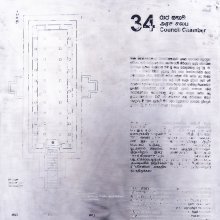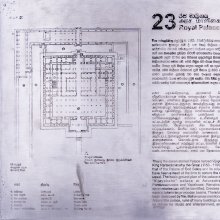Mantapa, Maṇṭapa, Mamtapa: 3 definitions
Introduction:
Mantapa means something in Hinduism, Sanskrit. If you want to know the exact meaning, history, etymology or English translation of this term then check out the descriptions on this page. Add your comment or reference to a book if you want to contribute to this summary article.
Images (photo gallery)
(+1 more images available)
In Hinduism
Vastushastra (architecture)
Source: OpenEdition books: Architectural terms contained in Ajitāgama and RauravāgamaMaṇṭapa (मण्टप) refers to “see maṇḍapa”.—(For paragraphs cf. Les enseignements architecturaux de l'Ajitāgama et du Rauravāgama by Bruno Dagens)

Vastushastra (वास्तुशास्त्र, vāstuśāstra) refers to the ancient Indian science (shastra) of architecture (vastu), dealing with topics such architecture, sculpture, town-building, fort building and various other constructions. Vastu also deals with the philosophy of the architectural relation with the cosmic universe.
Languages of India and abroad
Sanskrit dictionary
Source: Cologne Digital Sanskrit Dictionaries: Monier-Williams Sanskrit-English DictionaryMaṇṭapa (मण्टप):—m. n. = maṇḍapa, [cf. Lexicographers, esp. such as amarasiṃha, halāyudha, hemacandra, etc.]
Sanskrit, also spelled संस्कृतम् (saṃskṛtam), is an ancient language of India commonly seen as the grandmother of the Indo-European language family (even English!). Closely allied with Prakrit and Pali, Sanskrit is more exhaustive in both grammar and terms and has the most extensive collection of literature in the world, greatly surpassing its sister-languages Greek and Latin.
Kannada-English dictionary
Source: Alar: Kannada-English corpusMaṃṭapa (ಮಂಟಪ):—
1) [noun] a structure of stone, bricks, mud or wood with a flat roof and usu. open on all sides for providing shelter for travellers.
2) [noun] a temporary shed errected for festive occasions.
3) [noun] an ornamental structure for worshipping or carrying an idol on festive occaions.
4) [noun] a royal court or meeting hall.
5) [noun] a platform in a public place where disputes are heard, decided by elders of the village or juries.
6) [noun] a small building built by the side of a main house.
7) [noun] a building, room where gambling games are played regularly.
8) [noun] a structure raised with poles for vines to spread on.
Kannada is a Dravidian language (as opposed to the Indo-European language family) mainly spoken in the southwestern region of India.
See also (Relevant definitions)
Starts with: Mamtapalu, Mantapaccelavu, Mantapada, Mantapadruma, Mantapakkiyan, Mantapakkottu, Mantapalam, Mantapam, Mantapappati, Mantaparaga, Mantaparagu, Mantapariti, Mantapavitu.
Ends with: Abhyamtaramamtapa, Anubhavamamtapa, Asthanamamtapa, Galimamtapa, Kalyanamamtapa, Madanamamtapa, Mogamamtapa, Mukhamamtapa, Natyamamtapa, Patamamtapa, Prapamamtapa, Ramgamamtapa, Sabhamamtapa, Tamamgamamtapa, Uyyalemamtapa, Vasamtamamtapa, Venkata-vilasa-mantapa, Yagamamtapa.
Full-text (+53): Mantapaccelavu, Mamtame, Mamteya, Mamtheya, Mandava, Mamtaya, Mamdavige, Mandapa, Itainalikai, Vastukirti, Vacantamantapam, Buddhisankirna, Cantiyamantapam, Patamantapam, Pallimantapam, Venkata-vilasa-mantapa, Astanamantapam, Vishalaka, Sushlishta, Tapanamantapam.
Relevant text
Search found 6 books and stories containing Mantapa, Maṇṭapa, Mamtapa, Maṃṭapa; (plurals include: Mantapas, Maṇṭapas, Mamtapas, Maṃṭapas). You can also click to the full overview containing English textual excerpts. Below are direct links for the most relevant articles:
A Fine Vijayanagar < [April – June, 1983]
Theatre-Architecture in Ancient India < [January-February 1933]
"Prabhu Devara Ragale" < [April 1940]
Kashyapa Shilpa-shastra (study) (by K. Vidyuta)
1. Definition of Maṇḍapa (pavilions) < [Chapter 4 - Maṇḍapa Lakṣaṇa]
Hindu Pluralism (by Elaine M. Fisher)
The Tiruviḷaiyāṭal Purāṇam in Seventeenth-century Madurai < [Chapter 4 - The Language Games of Śiva]
The Public Theologians of Early Modern South India < [Chapter 1 - Hindu Sectarianism: Difference in Unity]
The Religion and Philosophy of Tevaram (Thevaram) (by M. A. Dorai Rangaswamy)
Nayanar 56: Pugazh Thunai (Pukalttunai) < [Volume 4.1.1 - A comparative study of the Shaivite saints the Thiruthondathogai]
Nayanar 40: Poyyatimai illata pulavar < [Volume 4.1.1 - A comparative study of the Shaivite saints the Thiruthondathogai]
Chapter 12 - Thirupanaiyur or Tiruppanaiyur (Hymn 87) < [Volume 3.2 - Pilgrim’s progress: to Chola]
Temples of Munnur (Historical Study) (by R. Muthuraman)
Role of Village Assemblies < [Chapter 7]
Preceptors of Advaita (by T. M. P. Mahadevan)
Related products






